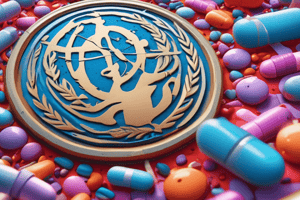Podcast
Questions and Answers
What is one of the World Health Organization's (WHO) five minimum requirements for a functional national PV system?
What is one of the World Health Organization's (WHO) five minimum requirements for a functional national PV system?
- A national pharmacovigilance law
- Regular audits of the PV system
- A dedicated PV budget
- Existence of a national spontaneous reporting system (correct)
Spontaneous reporting is the primary source of drug safety data during clinical trials.
Spontaneous reporting is the primary source of drug safety data during clinical trials.
False (B)
What is the name of the reporting system managed by the Uppsala Monitoring Centre (UMC) to which member states of the WHO Programme for International Drug Monitoring submit ICSRs for accurate international analysis?
What is the name of the reporting system managed by the Uppsala Monitoring Centre (UMC) to which member states of the WHO Programme for International Drug Monitoring submit ICSRs for accurate international analysis?
VigiBase
In 2011, _____________ of Sub-Saharan African countries had a spontaneous reporting system in place.
In 2011, _____________ of Sub-Saharan African countries had a spontaneous reporting system in place.
Match the following entities with their roles in pharmacovigilance:
Match the following entities with their roles in pharmacovigilance:
Flashcards are hidden until you start studying
Study Notes
Definition of Spontaneous Reporting
- Spontaneous reporting is an unsolicited communication by a healthcare professional or consumer to a company, regulatory authority, or other organization that describes one or more adverse drug reactions in a patient who was given one or more medicinal products.
- It does not derive from a study or any organized data collection scheme (ICH 2003).
Characteristics of Spontaneous Reporting Systems (SRS)
- Passive approach to pharmacovigilance (PV), relying entirely on the motivation of individuals to report suspected adverse drug reactions (ADRs).
- Can be paper-based (e.g. UK 'Yellow Card' system) or electronic (online reporting or mobile applications).
- Single reports from individual patients submitted to pharmacovigilance centres via SRS are known as Individual Case Study Reports (ICSRs).
- Information from multiple ICSRs is used to identify potential 'signals' – suggestions of casual associations between a medicinal product and a previously unknown reaction.
Importance of Spontaneous Reporting
- Covers all medicine use within a whole population for an unlimited time period (WHO 2006), encompassing the entire product life cycle of each medicine.
- Considered the mainstay of ADR reporting, with the existence of a national spontaneous reporting system being one of the World Health Organization's (WHO) five minimum requirements for a functional national PV system (WHO 2010).
- Basis of the WHO Programme for International Drug Monitoring's (PIDM) reporting system VigiBase, to which member states submit ICSRs for accurate international analysis (UMC 2019).
Global Pharmacovigilance System
- Strength lies in the integration of national and industry PV systems.
- The UMC, alongside MAHs and national RAs, are one of the 3 main players in PV at a global level, each with its own goals and perspectives when conducting PV activities (Schurer 2019).
- Many developing member countries lack the capacity and capability to take full advantage of the services offered by the UMC (Schurer 2019).
Advantages of Spontaneous Reporting
- Wide coverage means rare, serious ADRs not detected during earlier trials or through other pharmacovigilance methodologies may be revealed (WHO 2006).
- Generates most drug safety data, even more so than clinical trials during drug development (Lester et al., 2013).
- Relative ease of operation and low cost, coverage of whole patient populations and lifecycle follow-up of medicines, non-interference with prescribing habits, and potential to allow for follow-up studies make them a practical and inviting approach for LMICs (Isah, Pal et al. 2012).
Studying That Suits You
Use AI to generate personalized quizzes and flashcards to suit your learning preferences.




